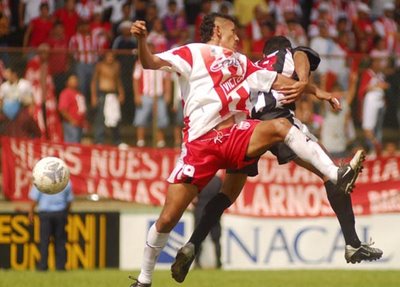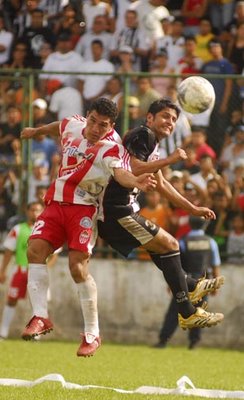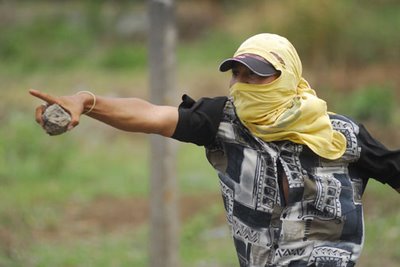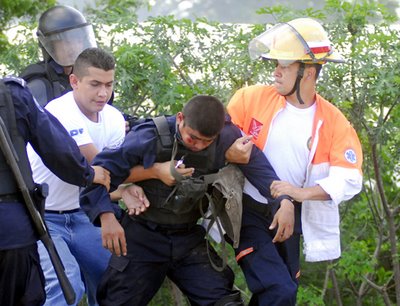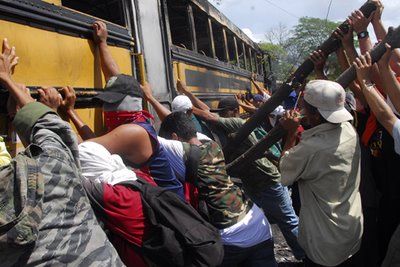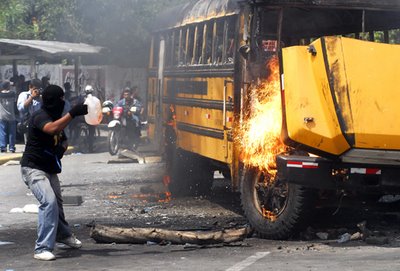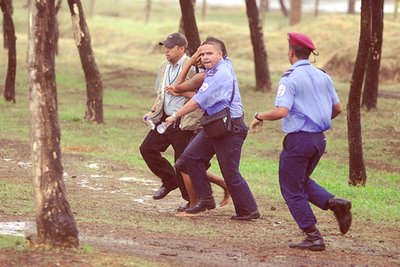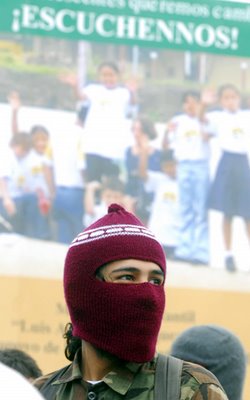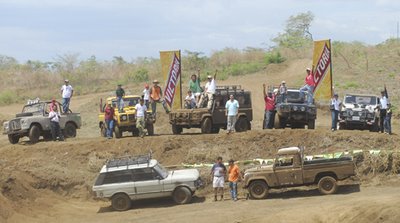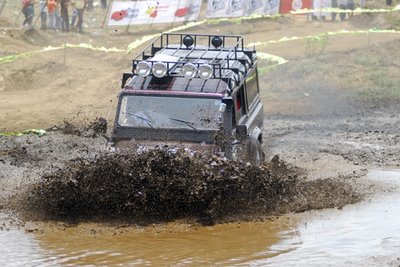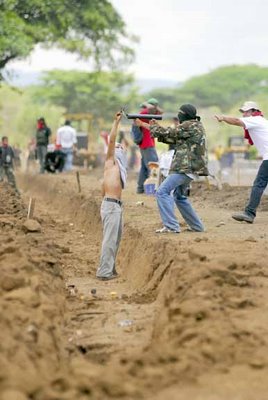Football, Soccer, Futbol!
The real thing! Some sports comentators in Nicaragua say that baseball is king, but football is a close second. This past Sunday was the championship game for Nicaraguan football. The two power houses, Real Esteli and Caciques del Diriangen met at the National Stadium Cacique Diriangen to settle who would be this year's champion. Diriangen won with an aggregate socre of 2 to 1. Real Esteli went home with its hands empty. In other countries football is a fanatical religion and going to the stadium is always frought with risk. Here in Nicaragua the game is still a freindly match in which both player and spectators come for the love of the game. It is passionate and fun to watch. The stadiums are small and there is a certain intimicacy between fans and players. This small league of clubs that is growing slowly each year is posed to surpass baseball as the national sport in the near future, and thus welcoming Nicaragua into the mainstream of Latin American sports once and for all.
How do you cover a football match?
Piece of cake. You can take your choice on long lenses. A 300 f/2.8 is a standard piece of equipment ,although if you know what you are doing a 70-200 f/2.8 is just as good. Others take a 400 f/2.8. Whatever your are confortable with, to get the job done is good enough. A fast camera is essential. At least 5 fps, anything slower will not do. At LA PRENSA we use Nikon gear. I have not been very happy with the performance of Nikon's D1H's. Supposedly built as sports cameras but thier performance in general left much to be desired. The D1's had a very bad shutter release lag that threw out your timing when covering sports. And in sports photography, timing is everything. The new D2's and D200 have much better performance and I am much happier with them. I am still sore at Nikon for building such lemmons but that's aonther whole blog for the future.
As a single shooter covering a game with a 300 f/2.8 or 400 f/2.8 you should position yourself as close as you can to the corner flag on the end line. FIFA regulations usually only allow photographers on the end line anyway From that position you will be able to get the players when they are running down the wings towards your position with the ball, usually with some defender in hot persuit. When the forward centers the ball to area in front of the goal you can follow the action with your long lense and you sould be able to get any action that happens there. That action will vary, from the goaly catching the ball, to defender and attackers heading the ball it into or away from the goal, defenders fouling an atacker or a goal score itself, also collisions. Once a goal is scored you should follow the scoring players reaction. Scoring players will either run celebrating and screaming in jubilation towards his bench, the corner flag or towards the team's fans. If he runs towards your corner flag be ready to wip out that second camera body with a wide angle lense. If he runs towards the fans then follow him with your long lens. After shooting the celebration make sure to take quick photo of the scoreboard to get the score, time and name of scorer.
Always try to time your shot to the moment when a player strikes the ball with any part of his body. That should be your starting shot. Then follow through untill the end of the play. No football in the frame, no picture. All play action shots need a football. I know of some Central American newspapers that keep a digital file of footballs to paste to play action shots with no footballs. Ingenious solution to that problem but highly unethical. We do not tolerate that, here in LA PRENSA.
During corner kicks it's best to concentrate on the goaly or the players in the area in front of the goal for action shots. Keep both eyes open to see when the football is kicked into play and when the action starts.
During free kicks its best co concentrate on the goaly. Most players will attempt to score from a free kick so the goaly will be directly on the recieving end of that shot. In most cases the goaly will lead you to the action in front of the goal, since he will be attempting to catch the ball himself or punch it out of the way.
Its also good to get a good shot of the coaches. Most soccer coaches will be on the sidelines within their dugout box yelling and gesticulating instructions to the players. Thats a good ocassion to get images of the coaches.
If you choose a 70-200 f/2.8 then your position is on and the end line about half way to the goal. This is a very confortable spot to shoot from. Very good to get action in front of the goal.
Always keep an eye out for the fans in the stands. You will get unusual situations and reaction, or even a fight between rival fans.
If you have a camera with a remote controll you can position it behind the a goal net with a super wide angle lense and wait for any action in the goal, then fire away. You should get some good results from this. It works great for penalty shots.
During penalty shots concentrate on the goaly trying to catch or block the ball. If the penalty shot goes in then switch quickly to the scoring player celebrating. If the goaly deflects the ball then follow the ball untill a player either kicks it in or clears it away. If you get involved in a penalty shootout follow this same routine. During the last penalty shot wich will difine who wins, get ready to capture the dejection of the goaly and the celebrating of the scoring player with his mates. Or the other way around, the goaly celebrating his game winning save and the dejection of the player who missed the shot.
Always get players beeing expelled from the game. They will be shown a red card by the referee. Thats the image you need. Players will discuss and try to intimidate the referee and sometimes even strike him. Stick through the whole scene all the way to the end when either the player leaves the field or the confrontation escalates.
Its very easy to be distracted during a football game so you have to make an extra effort to concentrate all the way to the end of the game. Thats makes the difference between average and great coverage. There is an old story of a veteran photojournalist in Costa Rica sent to cover a football championship game. When he came back to his editor without the the image of the winning goal he gave some lame technical excuse as to why he did not have the shot. His editor bought it. The next day on the competing newspaper, on the front page was the picture of the winning goal, and in the background you could see our photojournalist jumping in the air with exitement as his team scored. Needless to say he was in trouble. The point is that concentration is key. If you loose it you loose the picture.
In most Latin American countries fans will overun the field at the end of the game, especialy if it's the championship game. Be ready to move with your gear. Carry a a backpack so you can lug all of your gear in one confortable package. The winning team will be given the trophy at a short ceremony shoot it. Then they, along with the fans will run in a circuit around the field showing the trophy to the fans in the stands. These are difficult shots to get because of all of the extra people running along witht the players but they are worth it. You can run along with them with a wide angle lense or you can pick a spot and wait them out as the come around with your long lense.
Well that's it for now. Here are the pics. All of these where shot with a 70-200 f/2.8, at maximun aperture and focal distance to get a fast shutter speed and blown out backgorund.

